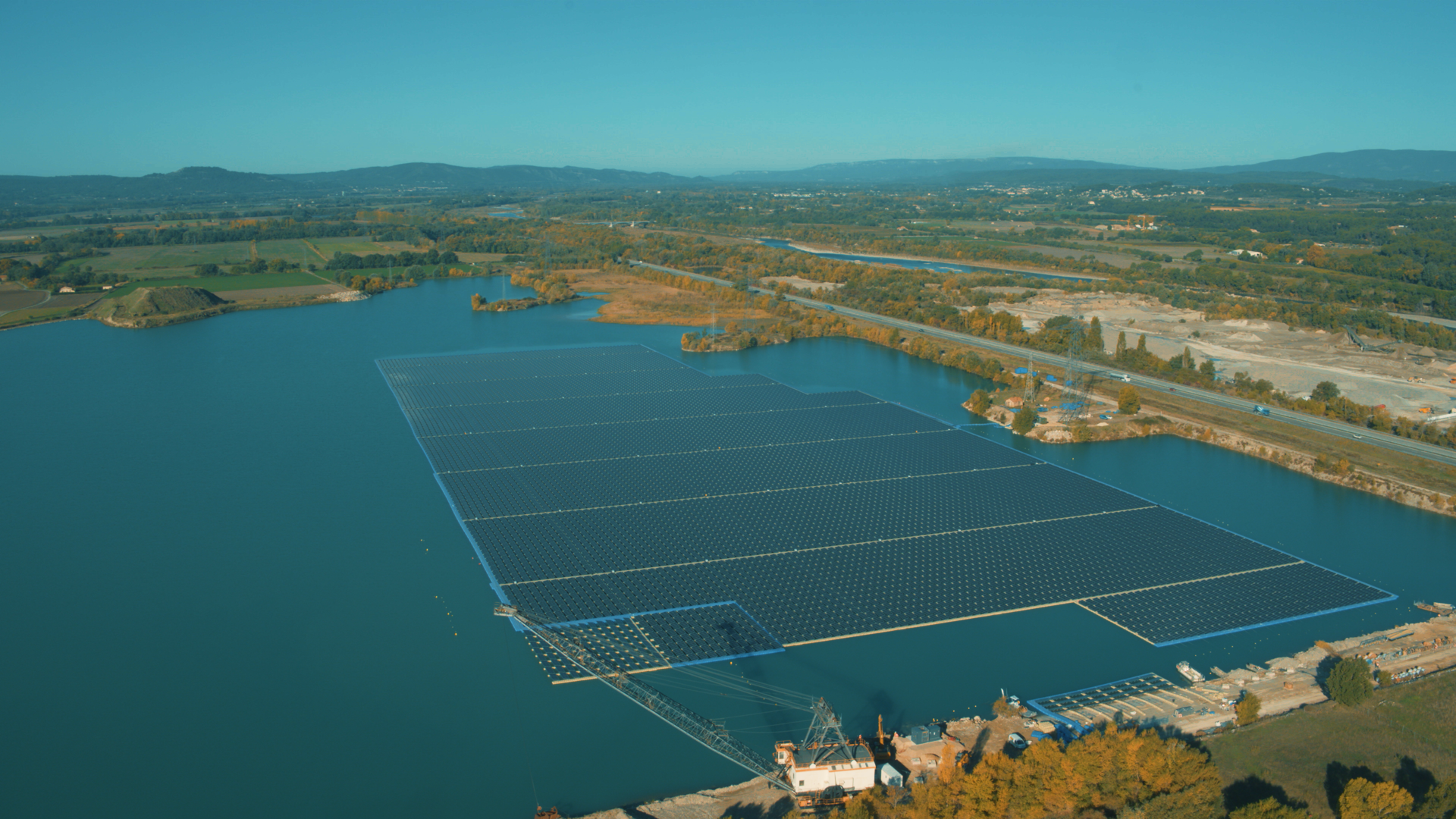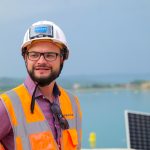France: Quarry lake makes comeback as solar farm

In Peyrolles-en-Provence, a small municipality 50 km from Marseille, industrial activity makes way to the production of solar energy. About half of the local population can now source green energy directly in their backyard.
A reference project for client Boralex
A decommissioned quarry lake, resulting from the extraction of silico-limestone alluvials, now houses a solar power plant that produces more than 22 GWh annually. This is equivalent to the annual consumption of 25 000 residents (6,400 households).
The particularity of this solar farm featuring 43,000 photovoltaic panels for an installed capacity of 12 MWac is that life vests are required on site.
Omexom in France built the floating solar farm, an energy producing island of 12.6 hectares, for its client Boralex, for whom Peyrolles will be the first floating solar technology asset.
The Canadian group primarily known for wind energy projects hereby takes an important step in its diversification. The project’s successful completion was crucial to confirm it as a reference.
“We are proud of the trust Boralex placed in our team and to have taken part in such a challenge.”
Julien Desseignes
Project Manager Omexom
“We are proud of the trust Boralex placed in our team and to have taken part in such a challenge,” said Julien Desseignes, Project Manager at Omexom. “This success is the benefit of a strong collaboration between Omexom and Boralex as well as all stakeholders.”
Since 2016, Boralex, commissioned by the municipality of Peyrolles and site owner, Durance Granulats, a VINCI company, has studied the environmental, landscape, and technical issues to design a user-friendly, sustainable technological solution.
Calling all specialists
Omexom worked together with several other specialists, including fellow VINCI Group companies Eurovia (related earthworks) and VINCI Construction Maritime et Fluvial (anchoring). Construction started in May 2021; seven month later, Peyrolles has started producing.
Hitting the on switch is a big achievement for everyone involved: “The Peyrolles-en-Provence site is the result of significant engineering work and consultation with stakeholders. […] Today we are very proud to see the site producing its first electrons,” so Nicolas Wolff, Vice-President and General Manager Boralex, Europe, in a press release.
‘’The Peyrolles-en-Provence site is the result of significant engineering work and consultation with stakeholders. […] We are very proud to see the site producing its first electrons.”
Nicolas Wolff
Vice-President and General Manager Boralex, Europe
Revaluing degraded land
The project was selected as part of a call for tenders by the French energy regulator and aligns with the push for development of solar photovoltaic power plants on degraded land, such as former waste management sites, brownfield areas or quarries. In France, land is hard to come by and expensive.
While offering the advantage of adding value to land with low agricultural or economical potential, complicated ground conditions on this type of site tend to require extensive and expensive civil works, or, in the case of Peyrolles, innovative solutions.
Omexom, besides offering turnkey solutions, regularly supports developers in the revaluation of this type of terrain.
Ingenuine technical solutions
46 000 plastic (HDPE) floats, typically used for temporary docks in ports and able to resist a charge of 350 kg /m² and 11,000 aluminum frames, make up the island supporting the panels.
Below the surface, a system of chains, buoys, cables, and anchorages hold the plant in place, allowing for a variation in water levels of up to 5 meters and resisting winds of up to 200 km/h.
The anchorages, built on land, were transported by boat to their destination. Professional divers were part of the construction team, intervening after the anchorages were dropped to fine tune their placement.
Ninety-six separate floating units were also assembled on land together with the panels before being sent into the water and combined to form one big island.
Flexible cables connect the island to two converter stations.
Copyright photos: Boralex SAS
Multiple technical advantages
While initial installation costs of floating PV plants are higher than for their ground-mounted equivalents, maintenance costs are lower and productivity higher.
The proximity to the water surface has a cooling effect on the solar equipment and makes for a higher return in the long run, expected to be about 10 to 15 % overall.
A lower inclination of the panels also allows for the installation of a greater number and a better calibration to the surface area.
Exact numbers will be confirmed by the national research authority Institute National de l’Energie Solaire, who will be capturing and interpreting data over at least the first three years of operation.
Minimal impact
From the colours of the floats to the distance to the shoreline, numerous considerations ensure minimal environmental impact.
The lake also being a local recreation area managed by the municipality, the solar plant was conceived to coexist in harmony with local species, human or otherwise.
The panels occupy 30% of the surface of the lake; the rest remains allocated to educational and tourist development and to redevelopment into a natural area.
Residents will be able to continue enjoying the beach, volleyball fields, and walking trails, all while gaining access to clean energy.

